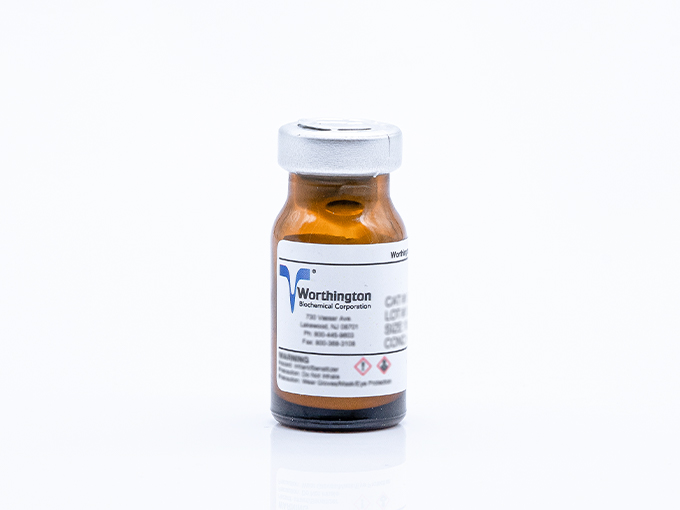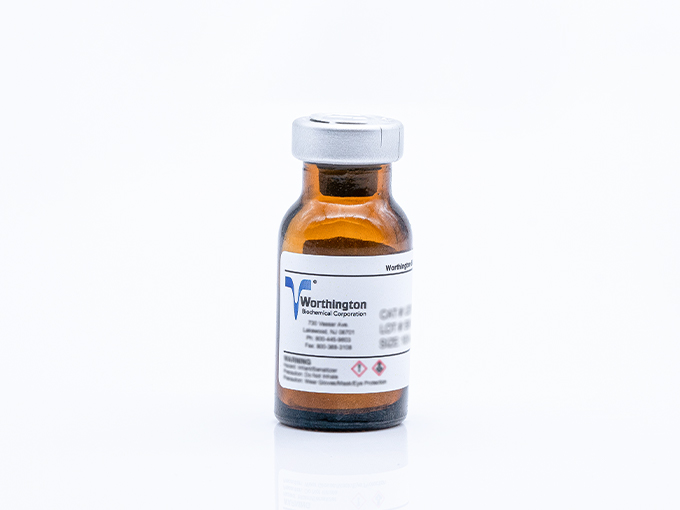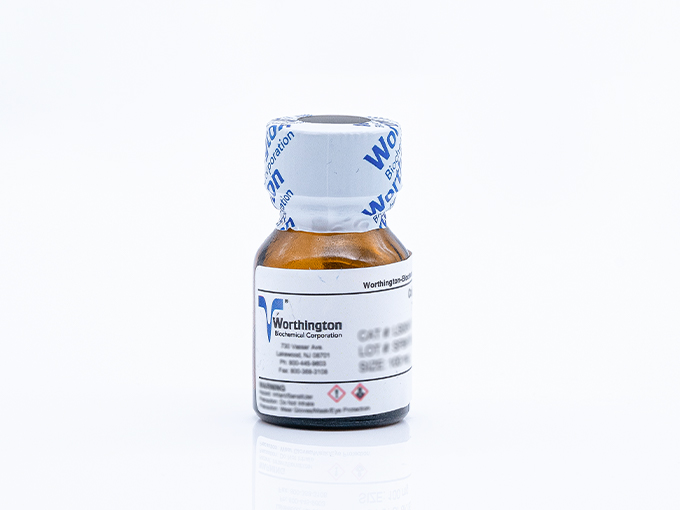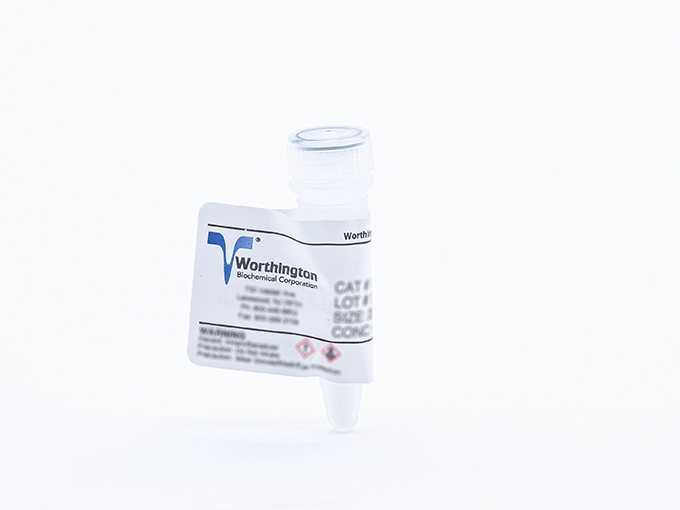Collagenase & Dispase
Collagenases for Tissue Dissociation and Bioprocessing
Collagenases from Clostridium histolyticum, also referred to as Clostridiopeptidase A, possesses a remarkable ability to cleave collagen, a key structural protein in connective tissues.
While many proteases can hydrolyze single-stranded, denatured collagen polypeptides, Clostridiopeptidase A is unique among proteases in its ability to attack and degrade the triple-helical native collagen fibrils commonly found in connective tissue.
Purified Clostridiopeptidase A alone is usually inefficient in dissociating tissues due to incomplete hydrolysis of all collagenous polypeptides and its limited activity against the high concentrations of non-collagen proteins and other macromolecules found in the extracellular matrix. For tissue dissociation, commonly used ‘Collagenases’ are collagenase preparations with additional enzymatic activities (side activity). They contain Collagenases, a Sulfhydryl Protease, Clostripain, a Trypsin-like Enzyme, and an Aminopeptidase. This combination of collagenolytic and proteolytic activities effectively breaks down intercellular matrices, particularly the peptide bonds present in native collagen.
Due to the varying compositions of extracellular matrices in different tissues and species, tailored collagenase preparations with optimized enzyme compositions have been developed. These are referred to as Type 1 to Type 7 for non-animal free products, and as Type A to Type D for the animal-free products. This classification helps determine the optimal enzyme mixture for the tissue type being used.
Explore the range of available Collagenase and Dispase® products, and find a detailed table of their preparation speciality, and common application.
Collagenase Test Program, Lot Reservation & Matching Service
Let us support your research by helping you select the most suitable collagenase for your specific tissue and experimental setup:
Collagenase Test Program & Lot Reservation
- Researchers can request 100 mg samples of up to two different lots for evaluation in their assay systems.
- A 4-week evaluation period is provided for testing.
- A minimum of 5 grams per lot will be placed on hold under your name.
- Once you determine the best-performing lot, simply specify it when placing your order.
Lot Matching Service
- To minimize variability when switching collagenase lots, we identify the closest match based on enzyme activity.
- Provide us with the collagenase lot number that worked well for your application, and we’ll find the best available alternative based on the enzymatic activity profile of this specific collagenase preparation (including side activities).
Dispase for Tissue Dissociation and Bioprocessing
Dispase®/Neutral Protease is an extremely stable non-specific metalloprotease which is produced by Paenibacillus polymyxa. Although related to trypsin, neutral protease is significantly less harmful to cells and can help prevent unwanted cell clumping without cell membrane damage. It cleaves fibronectin, collagen IV, and to a lesser extent collagen I, but it does not cleave collagen V or laminin. Thanks to its gentle proteolytic activity, this enzyme is particularly well-suited for preparing primary cells and for secondary cell culture (subcultivation), as it preserves cell membranes. Additionally, it serves as a secondary enzyme in cell isolation and tissue dissociation procedures, often in conjunction with Collagenases. It is commonly employed to separate the skin epidermis from the dermis while preserving epithelial sheets. Furthermore, it facilitates the isolation of stem cells, hepatocytes, and other cell types.
Animal Free (AF) Dispases® and Collagenases
AF Dispase and Collagenases, as well as optimized blends, are derived from cultures grown in medium completely devoid of animal-based components and designed for bioprocessing applications where introduction of potential animal derived pathogens must be prevented.
Find an overview of Preparations of Collagenase and Dispase®/Neutral Protease and their applications.
The choice and combination of enzymes depends on the tissue type, experimental requirements, and desired outcomes of the tissue dissociation procedure. The Worthingtons’ Tissue Dissociation Guide provides a collection of Tissue Dissociation Protocols for many different tissues from a broad spectrum of species.
DNase
DNase is also used in tissue dissociation and culture work to digest DNA from damaged cells thereby reducing viscosity, and removing membrane bound DNA fragments. Therefore, cell aggregation is prevented. Codes: DP and DCLS are suitable for these applications.
-
Collagenase Type 1 - CLS-1 (1g)
Cat.-Nr: LS004196
Collagenase Type 1 is a collagenase preparation with the original balance of enzymatic activities. Each lot assayed for collagenase, caseinase,... Read More
-
Collagenase Type 1, Filtered - CLSS-1 (5x50mg)
Cat.-Nr: LS004216
Collagenase, Type 1 (Code: CLS-1) is a collagenase peparation which has the original balance of collagenase, caseinase, clostripain and tryptic... Read More
-
Collagenase Type 2 - CLS-2 (1g)
Cat.-Nr: LS004176
Worthington Collagenase Type 2 is a collagenase enriched for clostripain and other proteolytic activities, recommended for efficient primary cell... Read More
-
Collagenase Type 2, Filtered - CLSS-2 (5x50mg)
Cat.-Nr: LS004204
Worthington Collagenase Type 2 is a collagenase preparation enriched for clostripain and other proteolytic activities, recommended for efficient... Read More
-
Collagenase Type 3 - CLS-3 (1g)
Cat.-Nr: LS004182
Lower in secondary proteolytic contaminant activities but with typical collagenase activity. Suggested for mammary primary cell isolation. A... Read More
-
Collagenase Type 3, Filtered - CLSS-3 (50mg)
Cat.-Nr: LS004206
Collagenase, Type 3 (Code: CLS-3) is a collagenase peparation which contains lowest levels of secondary proteases for gentle tissue... Read More
-
Collagenase Type 4 - CLS-4 (1g)
Cat.-Nr: LS004188
Collagenase Type 4 is a collagenase praparation prepared to contain lower tryptic activity levels to limit damage to membrane proteins and receptors... Read More
-
Collagenase Type 4, Filtered - CLSS-4 (5x50mg)
Cat.-Nr: LS004212
Collagenase, Type 4 (Code: CLS-4) is a collagenase peparation which is designed to be especially low in tryptic activity to limit damage to membrane... Read More
-
Collagenase Type 5 - CLS-5 (1g)
Cat.-Nr: LS005282
Partially purified to contain higher collagenase and caseinase activities. A dialyzed, lyophilized powder. =450 units per mg dry weight.Store at... Read More
-
Collagenase Type 5, Filtered - CLSS-5 (5x50mg)
Cat.-Nr: LS005287
Collagenase Type 5 (Code: CLSS-5), which is filtered through a 0.22 micron membrane and lyophilized in vials.
-
Collagenase Type 6 - CLS-6 (500mg)
Cat.-Nr: LS005319
Prepared to contain above normal collagenase, FALGPA and Caseinase activities and designed to be enriched with Type II (col H)... Read More
-
Collagenase Type 7 - CLS-7 (500mg)
Cat.-Nr: LS005333
Prepared to contain 4-5X more collagenase, FALGPA and Caseinase activities than Collagenase 1-4 and with moderate clostripain and tryptic... Read More
-
Collagenase Type A, Animal Free - CLSAFA (1g)
Cat.-Nr: LS004154
Prepared cultures grown in medium completely devoid of animal based components and designed for bioprocessing applications where introduction of... Read More
-
Collagenase Type A, Animal Free, Filtered - CLSAFAS (50mg)
Cat.-Nr: LS004118
Animal Free (AF) Types AFA, AFB, and AFC collagenases are derived from cultures grown in medium completely devoid of animal-based components and are... Read More
-
Collagenase Type B, Animal Free - CLSAFB (1g)
Cat.-Nr: LS004147
Prepared from cultures grown in medium completely devoid of animal based components and designed for bioprocessing applications where introduction of... Read More
-
Collagenase Type B, Animal Free, Filtered - CLSAFBS (50mg)
Cat.-Nr: LS004124
Animal Free (AF) Types AFA, AFB, and AFC collagenases are derived from cultures grown in medium completely devoid of animal-based components and are... Read More
-
Collagenase Type C, Animal Free - CLSAFC (1g)
Cat.-Nr: LS004140
Animal Free (AF) Types AFA, AFB, and AFC collagenases are derived from cultures grown in medium completely devoid of animal-based components and are... Read More
-
Collagenase Type C, Animal Free, Filtered - CLSAFCS (50mg)
Cat.-Nr: LS004130
Animal Free (AF) Types AFA, AFB, and AFC collagenases are derived from cultures grown in medium completely devoid of animal-based components and are... Read More
-
Collagenase Type D, Animal Free - CLSAFD (500mg)
Cat.-Nr: LS004162
Prepared from cultures grown in medium completely devoid of animal based components and designed for bioprocessing applications where introduction of... Read More
-
STEMxyme® 1 Collagenase/Neutral Protease (Dispase) - STZ1 (50mg)
Cat.-Nr: LS004106
A specialized combination of Animal Origin-Free Clostridium histolyticum collagenase (Code: CLSAFB) and animal origin free Bacillus polymyxa neutral... Read More
-
STEMxyme® 2 Collagenase/Neutral Protease (Dispase) - STZ2 (50mg)
Cat.-Nr: LS004112
A specialized combination of Animal Origin-Free Clostridium histolyticum collagenase (Code: CLSAFB) and animal origin free Bacillus polymyxa neutral... Read More
-
Collagenase Type 1 - CLS-1 (100mg)
Cat.-Nr: LS004194
The original balance of enzymatic activities. Each lot assayed for collagenase, caseinase, clostripain and tryptic activities. Suggested for... Read More
-
Collagenase Type 1 - CLS-1 (5g)
Cat.-Nr: LS004197
The original balance of enzymatic activities. Each lot assayed for collagenase, caseinase, clostripain and tryptic activities. Suggested for... Read More
-
Collagenase Type 1, Filtered - CLSS-1 (1g)
Cat.-Nr: LS004217
Collagenase, Type 1 (Code: CLS-1), which is filtered through a 0.22 micron membrane and lyophilized in vials.
-
Collagenase Type 1, Filtered - CLSS-1 (50mg)
Cat.-Nr: LS004214
Collagenase, Type 1 (Code: CLS-1), which is filtered through a 0.22 micron membrane and lyophilized in vials.
-
Collagenase Type 2 - CLS-2 (100mg)
Cat.-Nr: LS004174
Collagenase Type II (CLS-2, Collagenase Type II) is prepared to contain a higher clostripain activity. Suggested for bone, heart, liver, thyroid and... Read More
-
Collagenase Type 2 - CLS-2 (5g)
Cat.-Nr: LS004177
Prepared to contain higher clostripain activity. Suggested for bone, heart, liver, thyroid and salivary primary cell isolation. Supplied as a... Read More
-
Collagenase Type 2, Filtered - CLSS-2 (1g)
Cat.-Nr: LS004205
Collagenase, Type 2 (Code: CLS-2), which is filtered through a 0.22 micron membrane and lyophilized in vials. =125 units per mg dry weight
-
Collagenase Type 2, Filtered - CLSS-2 (50mg)
Cat.-Nr: LS004202
Worthington Collagenase Type 2 is a collagenase preparation enriched for clostripain and other proteolytic activities, recommended for efficient... Read More
-
Collagenase Type 3 - CLS-3 (100mg)
Cat.-Nr: LS004180
Lower in secondary proteolytic contaminant activities but with typical collagenase activity. Suggested for mammary primary cell isolation. A... Read More
-
Collagenase Type 3 - CLS-3 (5g)
Cat.-Nr: LS004183
Lower in secondary proteolytic contaminant activities but with typical collagenase activity. Suggested for mammary primary cell isolation. A... Read More
-
Collagenase Type 3, Filtered - CLSS-3 (5x50mg)
Cat.-Nr: LS004208
Collagenase, Type 3 (Code: CLS-3), which is filtered through a 0.22 micron membrane and lyophilized in vials to contain ≥ 50 milligrams per vial.
-
Collagenase Type 4 - CLS-4 (100mg)
Cat.-Nr: LS004186
Prepared to contain lower tryptic activity levels to limit damage to membrane proteins and receptors but with normal to above normal collagenase... Read More
-
Collagenase Type 4 - CLS-4 (5g)
Cat.-Nr: LS004189
Prepared to contain lower tryptic activity levels to limit damage to membrane proteins and receptors but with normal to above normal collagenase... Read More
-
Collagenase Type 4, Filtered - CLSS-4 (1g)
Cat.-Nr: LS004209
Collagenase, Type 4 (Code: CLS-4), which is filtered through a 0.22 micron membrane and lyophilized in vials. =160 units per mg dry weight
-
Collagenase Type 4, Filtered - CLSS-4 (50mg)
Cat.-Nr: LS004210
Collagenase, Type 4 (Code: CLS-4), which is filtered through a 0.22 micron membrane and lyophilized in vials to contain ≥ 50 milligrams per vial.
-
Collagenase Type 5 - CLS-5 (100mg)
Cat.-Nr: LS005280
Partially purified to contain higher collagenase and caseinase activities. A dialyzed, lyophilized powder. =450 units per mg dry weight.Store at... Read More
-
Collagenase Type 5 - CLS-5 (5g)
Cat.-Nr: LS005283
Partially purified to contain higher collagenase and caseinase activities. A dialyzed, lyophilized powder. =450 units per mg dry weight.Store at... Read More
-
Collagenase Type 5, Filtered - CLSS-5 (1g)
Cat.-Nr: LS005288
Collagenase Type 5 (Code: CLS-5), which is filtered through a 0.22 micron membrane and lyophilized in vials.
-
Collagenase Type 5, Filtered - CLSS-5 (50mg)
Cat.-Nr: LS005286
Collagenase Type 5 (Code: CLSS-5), which is filtered through a 0.22 micron membrane and lyophilized in vials.
-
Collagenase Type 6 - CLS-6 (100mg)
Cat.-Nr: LS005318
Prepared to contain above normal collagenase, FALGPA and Caseinase activities and designed to be enriched with Type II (col H)... Read More
-
Collagenase Type 6 - CLS-6 (2.5g)
Cat.-Nr: LS005321
Prepared to contain above normal collagenase, FALGPA and Caseinase activities and designed to be enriched with Type II (col H)... Read More
-
Collagenase Type 7 - CLS-7 (100mg)
Cat.-Nr: LS005332
Prepared to contain 4-5X more collagenase, FALGPA and Caseinase activities than Collagenase 1-4 and with moderate clostripain and tryptic... Read More
-
Collagenase Type 7 - CLS-7 (2.5g)
Cat.-Nr: LS005335
Prepared to contain 4-5X more collagenase, FALGPA and Caseinase activities than Collagenase 1-4 and with moderate clostripain and tryptic... Read More
-
Collagenase Type A, Animal Free - CLSAFA (100mg)
Cat.-Nr: LS004152
Prepared cultures grown in medium completely devoid of animal based components and designed for bioprocessing applications where introduction of... Read More
-
Collagenase Type A, Animal Free - CLSAFA (5g)
Cat.-Nr: LS004156
Prepared cultures grown in medium completely devoid of animal based components and designed for bioprocessing applications where introduction of... Read More
-
Collagenase Type A, Animal Free, Filtered - CLSAFAS (5x50mg)
Cat.-Nr: LS004119
Collagenase, Animal Origin-Free (Code: CLSAFA) which is filtered through a 0.22 micron membrane and lyophilized in vials.
-
Collagenase Type B, Animal Free - CLSAFB (100mg)
Cat.-Nr: LS004145
Prepared from cultures grown in medium completely devoid of animal based components and designed for bioprocessing applications where introduction of... Read More
-
Collagenase Type B, Animal Free - CLSAFB (5g)
Cat.-Nr: LS004148
Prepared from cultures grown in medium completely devoid of animal based components and designed for bioprocessing applications where introduction of... Read More
-
Collagenase Type B, Animal Free, Filtered - CLSAFBS (5x50mg)
Cat.-Nr: LS004125
Collagenase, Animal Origin Free (Code: CLSAFB) which is filtered through a 0.22 micron membrane and lyophilized in vials.




